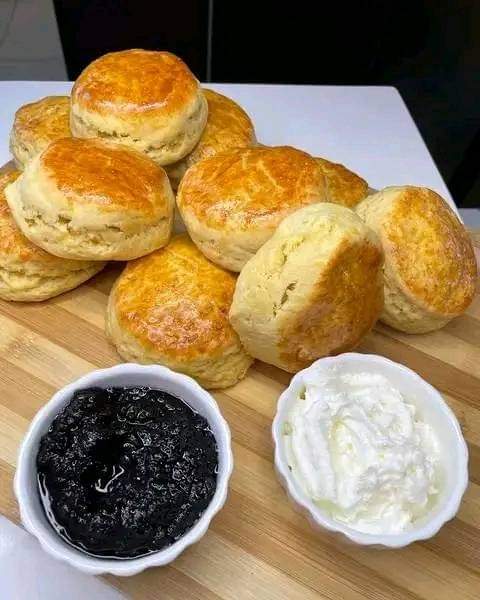Scones can be a delicious and versatile treat that can offer certain health and nutritional benefits when prepared with the right ingredients. Here are some potential benefits of a scone recipe that includes nutritious ingredients:
1. Whole Grains: Opting for whole grain flour in your scone recipe can provide a good source of dietary fiber, which can aid in digestion, help maintain bowel regularity, and contribute to a feeling of fullness. Whole grains also contain important vitamins, minerals, and antioxidants.
2. Protein: Adding ingredients like nuts, seeds, or even a small amount of protein powder to your scone recipe can increase the protein content. Protein is essential for building and repairing tissues, supporting a healthy immune system, and promoting satiety.
3. Healthy Fats: Using ingredients like olive oil, coconut oil, or nut butters can add healthy fats to your scones. Healthy fats, such as monounsaturated and polyunsaturated fats, can help reduce inflammation, support brain health, and improve nutrient absorption.
4. Fruit and Vegetables: Incorporating fruits or vegetables into your scone recipe, such as berries, grated carrots, or zucchini, can increase the fiber and nutrient content. Fruits and vegetables provide essential vitamins, minerals, and antioxidants that support overall health and well-being.
5. Reduced Sugar: Reducing the amount of sugar in your scone recipe or using natural sweeteners like honey or maple syrup can help lower the overall sugar content. High sugar consumption is linked to various health issues, including obesity, diabetes, and tooth decay.
6. Customization: Scones can be easily customized to meet specific dietary needs or preferences. For example, you can make gluten-free scones by using gluten-free flour or cater to vegan diets by using plant-based milk and egg substitutes.
Remember, while scones can be a part of a balanced diet, it’s still important to consume them in moderation and consider portion sizes. Additionally, the overall nutritional value of scones will depend on the specific ingredients and quantities used in your recipe.
SCONES RECIPE

INGREDIENTS
◾️10 cups all wheat cake flour
◾️10 tsp of baking powder
◾️1 tsp of bicarbonate of soda
◾️2 cups of sugar
◾️500g of butter
◾️3 large eggs
◾️1cup of custard cream
◾️1 tsp of vanilla extract
◾️2 cups of plain yoghurt
METHOD
◾️Sift flour into the mixing bowl.
◾️Add all the dry ingredients into the flour, 10 tsp of baking powder, 1 tsp bicarbonate of soda and 2 cups of sugar.
◾️Add the butter into the flour mixture and scramble with your fingers until it resembles bread crumbs.
◾️In a different mixing bowl,add the eggs, plain yogurt, custard cream and vanilla extract then mix well.
Pour the egg mixture into the flour mixture and mix well.
(Do not over mix.)
◾️Lay the dough into a floured surface and roll it out.
◾️Cut out the scones using a cookie cutter.
◾️Put the cookies into a greased baking tray, then brush with an egg wash.
◾️Bake at 170°c until golden.
Certainly! Here are some tips to help you achieve delicious and perfectly baked scones:

1. Keep Ingredients Cold: It’s important to keep your butter and any other fats cold when making scones. Cold fats help create a flaky texture. You can even freeze the butter and grate it into the dry ingredients for easier incorporation.
2. Don’t Overmix: When combining the wet and dry ingredients, mix just until everything comes together. Overmixing can result in tough scones. A few lumps in the dough are perfectly fine.
3. Use Proper Flour: Use a flour with a moderate protein content, like all-purpose flour, for a balanced texture. If you prefer a lighter texture, you can use cake flour, which has a lower protein content.
4. Add Flavorful Ingredients: Enhance the taste and texture of your scones by incorporating flavorful ingredients such as dried fruit, chocolate chips, nuts, or citrus zest. Fold them into the dough gently to distribute them evenly.
5. Shape the Dough Correctly: Turn the dough out onto a lightly floured surface and gently shape it into a circle or rectangle, about 1 inch thick. Avoid excessive handling, as this can result in tough scones.
6. Use a Hot Oven: Preheat your oven to a high temperature, usually around 400-425°F (200-220°C). A hot oven helps create a nice rise and golden crust on the scones.
7. Brush with Egg Wash: Before baking, brush the tops of your scones with an egg wash made by whisking an egg with a little milk or water. This will give them a lovely golden color.
8. Mind the Baking Time: Bake your scones for the recommended time, but keep a close eye on them. Overbaking can result in dry scones. They should be golden brown on the outside and cooked through but still tender inside.
9. Cool Properly: Once baked, transfer the scones to a wire rack to cool. Allowing them to cool completely before enjoying will help retain their texture and prevent them from becoming soggy.
10. Serve Fresh: Scones are best enjoyed fresh on the day they are baked. However, you can store any leftovers in an airtight container for a day or two. Reheat them briefly in the oven or toaster before serving to restore their freshness.
Remember, these tips are general guidelines, and you can adjust them based on your personal preferences and dietary needs. Enjoy your homemade scones!